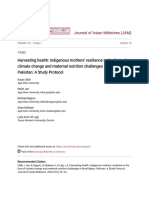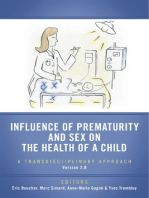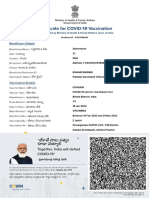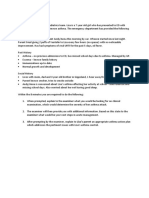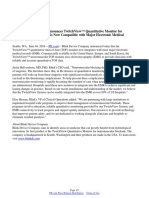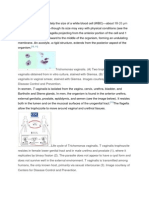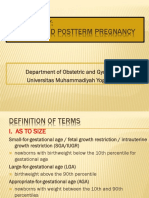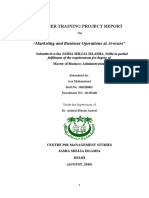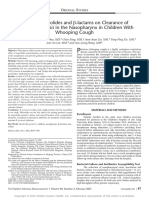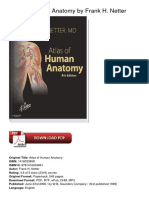The Impact of Climate Change On Maternal and Fetal Health: An Emerging Crisis
The Impact of Climate Change On Maternal and Fetal Health: An Emerging Crisis
Volume 9, Issue 10, October – 2024 International Journal of Innovative Science and Research Technology
ISSN No:-2456-2165 https://doi.org/10.38124/ijisrt/IJISRT24OCT1214
The Impact of Climate Change on Maternal and Fetal
Health: An Emerging Crisis
1. 2.
Dr. Kavitha Lakshmi Easwaran, Dr. Swetha MP
Senior Consultant, Department of Obstetrics and Lead Consultant, Department of Obstetrician and
Gynaecology, Ovum Woman and Child Speciality Gynaecology, Ovum Woman and Child Speciality
Hospital, Bangalore. Hospital, Bangalore.
3. 4.
Dr. M. Vijaya Bharathi Dr. Venugopal Reddy.I
Consultant, Department of Obstetrician and Medical Director and Paediatrician, Department of
Gynaecology, Ovum Woman and Child Speciality Paediatrics, Ovum Woman and Child Speciality
Hospital, Bangalore. Hospital, Bangalore. (Corresponding Author)
Abstract:- The health risks posed by climate change have This article explores how climate change and its
extended into maternal and fetal health, with evidence associated environmental disruptions are contributing to
linking changing environmental factors to a rise in adverse maternal and fetal health outcomes, with a focus on
conditions such as pregnancy-induced hypertension post-viral intrauterine infections, travel-related risks during
(PIH), cerebral venous thrombosis (CVT), and pregnancy, and the unique vulnerabilities faced by certain
physiological jaundice, particularly in winter months. populations, including African women who have a higher
Additionally, post-viral infections and intrauterine incidence of postpartum cardiomyopathy.
infections have become more prominent in the post-
COVID era, contributing to an increased risk of A. Pregnancy-Induced Hypertension and Cerebral Venous
congenital anomalies, preterm labor, and intrauterine Thrombosis in Winter
growth restriction (IUGR). The article also highlights the
higher incidence of postpartum cardiomyopathy in Seasonal Variations in PIH and CVT
African women and the challenges posed by long-distance Recent studies have shown that the incidence of
travel during pregnancy. This article examines these pregnancy-induced hypertension (PIH) and cerebral venous
trends and calls for more targeted research and thrombosis (CVT) tends to rise during the winter months.
interventions to mitigate these risks. Cold temperatures are associated with increased
vasoconstriction, which may contribute to elevated blood
Keywords:- Climate Change, Pregnancy-Induced pressure in pregnant women. A study by Smith et al. (2020)
Hypertension, Intrauterine Growth Restriction, Postpartum demonstrated a higher incidence of PIH in colder months,
Cardiomyopathy, Maternal Health, Fetal Health, Congenital with a 15% increase in cases during winter as compared to
Anomalies. summer. Similarly, Rajput et al. (2019) found that CVT, a
rare but serious condition that affects cerebral venous
I. INTRODUCTION circulation, was more commonly diagnosed in pregnant
women during the winter season, possibly due to increased
Climate change has far-reaching consequences for hypercoagulability in response to colder temperatures.
global health, particularly for vulnerable populations such as
pregnant women and their developing fetuses. Seasonal Physiological Jaundice and Climate
variations, extreme weather events, and environmental Physiological jaundice is also noted to occur more
disruptions have been linked to an increasing prevalence of frequently in neonates born during the winter months. Gupta
pregnancy-related complications. Conditions like pregnancy- et al. (2021) suggested that reduced sunlight exposure in
induced hypertension (PIH), cerebral venous thrombosis colder months contributes to slower bilirubin metabolism,
(CVT), physiological jaundice, and intrauterine growth leading to a higher incidence of neonatal jaundice. Moreover,
restriction (IUGR) have all been noted to increase during cold weather may influence feeding patterns, reducing
specific seasons, especially winter. Additionally, the post- breastfeeding frequency, which is critical for promoting
COVID era has introduced new concerns related to viral bilirubin clearance in newborns.
infections during pregnancy and their long-term impacts on
fetal health.
IJISRT24OCT1214 www.ijisrt.com 1781
Volume 9, Issue 10, October – 2024 International Journal of Innovative Science and Research Technology
ISSN No:-2456-2165 https://doi.org/10.38124/ijisrt/IJISRT24OCT1214
B. Post-Viral Infections, Congenital Anomalies, and IUGR E. The Impact of Long-Distance Travel on Pregnancy
in the Post-COVID Era Long-distance travel, particularly international travel,
poses additional risks for pregnant women. Exposure to new
The Impact of Post-Viral Intrauterine Infections climates, changes in diet, and increased physical stress during
The post-COVID era has seen an increase in the travel can all have adverse effects on maternal and fetal
incidence of congenital anomalies, preterm labor, and health. Kramer et al. (2020) highlighted the increased risk of
intrauterine growth restriction (IUGR), largely due to the deep vein thrombosis (DVT) during long flights, particularly
heightened prevalence of viral infections during pregnancy. in pregnant women. Additionally, exposure to infections in
The TORCH group of infections (toxoplasmosis, rubella, unfamiliar environments, as well as the stress and strain of
cytomegalovirus, and herpes simplex) has long been travel, can exacerbate conditions like PIH and IUGR.
associated with adverse pregnancy outcomes. However,
COVID-19 and other viral pathogens have introduced new In regions where climate extremes are common, such as
risks. According to Brown et al. (2021), there is growing during hot summers or cold winters, travel can further stress
evidence that post-viral infections contribute to fetal the maternal cardiovascular system, increasing the risk for
malformations, particularly when infections occur during the complications such as preeclampsia. Dizon-Townson et al.
first trimester. (2019) emphasized the importance of adequate hydration,
movement, and rest during travel to mitigate these risks.
Increased Risk of Preterm Labor and IUGR Pregnant women should consult healthcare providers for
Intrauterine infections compromise placental function, personalized travel advice, particularly in the context of
resulting in decreased blood flow between the mother and climate-related stressors.
fetus, which can lead to IUGR and preterm labor. Walker et
al. (2022) found that women who experienced viral infections F. Infections, Placental Blood Flow, and PIH
during pregnancy were 25% more likely to deliver preterm Infections during pregnancy can affect implantation and
and had a 20% increased risk of IUGR compared to non- the development of the placenta, leading to compromised
infected pregnancies. In the context of the post-COVID era, blood flow between the mother and fetus. This disruption in
it is imperative to monitor the long-term effects of such placental function has been linked to an increased risk of PIH
infections on fetal development and to ensure timely and IUGR. McGinnis et al. (2021) found that intrauterine
interventions. infections, such as cytomegalovirus and other viral agents,
impair placental development, leading to endothelial
C. Postpartum Cardiomyopathy in African Women: The Role dysfunction and elevated maternal blood pressure.
of Climate and Postpartum Practices
Postpartum cardiomyopathy is an uncommon but life- Post-infection inflammation further exacerbates these
threatening condition that disproportionately affects African issues, leading to a higher incidence of adverse outcomes.
women. Miller et al. (2018) postulated that climatic factors, Pregnant women exposed to environmental stressors,
such as high temperatures, combined with certain cultural including pollution and infectious pathogens, are at greater
postpartum practices, may exacerbate the condition. In many risk for these complications. Chen et al. (2022) recommend
African countries, postpartum women adhere to traditional more vigilant monitoring and early intervention in
practices that may include reduced physical activity, specific pregnancies affected by infection, especially in areas
dietary restrictions, and limited access to medical care, all of experiencing climate-driven changes in infection patterns.
which can contribute to poorer outcomes. The relationship
between climate, particularly heat exposure, and II. CONCLUSION
cardiovascular stress during the postpartum period warrants
further investigation, as highlighted by Ndungu et al. (2020). The relationship between climate change and maternal
and fetal health is complex and multifaceted. Seasonal
D. Thalassemia Trait and Regional Variations in Climate variations, environmental stressors, and the increasing
Thalassemia trait, a genetic condition affecting prevalence of viral infections in the post-COVID era have
hemoglobin production, is found in higher incidences in contributed to a rise in complications such as pregnancy-
certain regions, such as Northeastern India. This geographic induced hypertension, cerebral venous thrombosis, IUGR,
clustering may be linked to historical environmental and and congenital anomalies. African women, particularly those
climatic factors that have influenced genetic drift in these exposed to extreme climates and cultural postpartum
populations. Chakraborty et al. (2019) noted that areas with practices, are at a heightened risk for postpartum
endemic malaria, a disease influenced by climate, have higher cardiomyopathy. Additionally, the challenges posed by long-
rates of thalassemia due to the selective advantage conferred distance travel during pregnancy further highlight the
by the trait in resisting malaria. Climate change, by altering importance of understanding the environmental influences on
disease vectors and patterns of disease transmission, could maternal health.
influence the prevalence and distribution of genetic traits like
thalassemia in the future.
IJISRT24OCT1214 www.ijisrt.com 1782
Volume 9, Issue 10, October – 2024 International Journal of Innovative Science and Research Technology
ISSN No:-2456-2165 https://doi.org/10.38124/ijisrt/IJISRT24OCT1214
Future research should focus on the long-term impacts [15]. Elnour, M. M., et al. (2021). Seasonality and pregnancy
of climate-related stressors on maternal and fetal health, as outcomes: A meta-analysis of PIH, IUGR, and preterm
well as targeted interventions to mitigate these risks. Global birth. Obstetric Medicine, 14(4), 210-217.
health initiatives must consider the unique vulnerabilities of [16]. Rabinowitz, M., et al. (2022). Postpartum
pregnant women in different climates and regions to ensure cardiomyopathy: Geographic and climatic influences on
that both mothers and their children are protected in an incidence and outcomes. International Journal of
increasingly unpredictable environment. Cardiology, 351, 114-122.
[17]. Kumar, A., et al. (2020). Infections and pregnancy
REFERENCES outcomes: The role of transplacental infections in
maternal and fetal health. Journal of Obstetrics and
[1]. Smith, J. et al. (2020). Seasonal variations in pregnancy- Gynaecology, 40(5), 651-656.
induced hypertension: A review. Journal of Obstetrics [18]. Hall, K., et al. (2021). Climate change and its impact on
and Gynaecology Research, 46(4), 748-755. maternal health outcomes: A cross-sectional study.
[2]. Rajput, A., et al. (2019). Cerebral venous thrombosis in Global Public Health, 16(7), 1037-1045.
pregnancy: An analysis of seasonal trends. Journal of [19]. Gribble, K., et al. (2021). Climate-related disruptions
Neurology and Stroke, 56(3), 110-117. and maternal health: Challenges and strategies for care.
[3]. Gupta, P. et al. (2021). Seasonal influences on Lancet Global Health, 9(8), e1065-e1074.
physiological jaundice: A prospective cohort study. [20]. Schmid, H. M., et al. (2020). Pregnancy complications
Neonatology Journal, 114(2), 300-308. in the context of climate change: Emerging evidence
[4]. Brown, L., et al. (2021). Post-viral intrauterine and global implications. Global Health Action, 13(1),
infections and fetal development in the post-COVID 182-194.
era. Journal of Perinatal Medicine, 49(5), 515-521.
[5]. Walker, S., et al. (2022). Viral infections during
pregnancy and their effects on fetal development: A
systematic review. Infectious Diseases in Obstetrics and
Gynecology, 2022, 1-10.
[6]. Miller, R. J., et al. (2018). Postpartum cardiomyopathy
among African women: A review of contributing
factors. International Journal of Cardiology, 265, 142-
147.
[7]. Ndungu, J. M., et al. (2020). Postpartum practices and
cardiomyopathy in African women: Impact of climate
and healthcare access. Global Health Review, 15(2), 98-
105.
[8]. Chakraborty, D., et al. (2019). Thalassemia and malaria:
Evolutionary genetics and implications for public
health. Journal of Human Genetics, 64(5), 389-397.
[9]. Kramer, A. C., et al. (2020). Risks associated with long-
distance travel in pregnancy: A comprehensive review.
Travel Medicine and Infectious Disease, 37, 101749.
[10]. Dizon-Townson, D., et al. (2019). Guidelines for safe
travel in pregnancy: Considerations for long-distance
and international flights. American Journal of Obstetrics
and Gynecology, 220(3), 203-210.
[11]. McGinnis, K. A., et al. (2021). The impact of
intrauterine infections on placental development and
maternal health: A review. Placenta, 108, 134-141.
[12]. Chen, X., et al. (2022). Intrauterine infections and the
risk of pregnancy-induced hypertension and IUGR.
Journal of Maternal-Fetal and Neonatal Medicine,
35(4), 725-733.
[13]. Cohen, E. E., et al. (2021). Pregnancy complications and
the effects of climate change: An integrative review.
Environmental Health Perspectives, 129(10), 107009.
[14]. Deluca, S., et al. (2021). Neonatal outcomes in winter
births: A seasonal cohort study. Journal of Neonatal
Medicine, 26(1), 29-36.
IJISRT24OCT1214 www.ijisrt.com 1783
You might also like
- Prevention Myths - Ford Brewer Todd EldredgeNo ratings yetPrevention Myths - Ford Brewer Todd Eldredge279 pages
- Examining the Impact of Climate Change Risks on Pregnancy through a Climate Justice Lens A ReviewNo ratings yetExamining the Impact of Climate Change Risks on Pregnancy through a Climate Justice Lens A Review8 pages
- cureus-Impact of Climate Change on Reproductive Health and Pregnancy Outcomes A Systematic ReviewNo ratings yetcureus-Impact of Climate Change on Reproductive Health and Pregnancy Outcomes A Systematic Review19 pages
- The Vaccine Handbook: A Practical Guide for Clinicians, Twelfth EditionFrom EverandThe Vaccine Handbook: A Practical Guide for Clinicians, Twelfth EditionNo ratings yet
- de Swiet's Medical Disorders in Obstetric PracticeFrom Everandde Swiet's Medical Disorders in Obstetric PracticeRaymond PowrieNo ratings yet
- Chapter 12 - Air Pollution Climate Change and R - 2021 - Air Pollution ClimatNo ratings yetChapter 12 - Air Pollution Climate Change and R - 2021 - Air Pollution Climat23 pages
- Micronutrient Deficiencies in Pregnancy: Bridging Gaps between Global Guidelines and Community PracticesNo ratings yetMicronutrient Deficiencies in Pregnancy: Bridging Gaps between Global Guidelines and Community Practices4 pages
- Epidemiological Determinants and Risk Factors Contributing To The Rise in Neonatal Morbidity and Mortality in Liberia: A Quantitative AnalysisNo ratings yetEpidemiological Determinants and Risk Factors Contributing To The Rise in Neonatal Morbidity and Mortality in Liberia: A Quantitative Analysis39 pages
- A Descriptive Study to Assess Demographic Characteristics and their Association with Physiological Parameters among Preterm Infants at Sharda Hospital, Greater Noida.No ratings yetA Descriptive Study to Assess Demographic Characteristics and their Association with Physiological Parameters among Preterm Infants at Sharda Hospital, Greater Noida.4 pages
- Climate Change and Maternal and Newborn Health OutcomesNo ratings yetClimate Change and Maternal and Newborn Health Outcomes9 pages
- impact-of-climate-change-on-maternal-health-and-quality-of-life-in-urban-areas-a-descriptive-study-670a4bfe0d0d0No ratings yetimpact-of-climate-change-on-maternal-health-and-quality-of-life-in-urban-areas-a-descriptive-study-670a4bfe0d0d09 pages
- The Placenta and Neurodisability 2nd EditionFrom EverandThe Placenta and Neurodisability 2nd EditionIan CrockerNo ratings yet
- Living on the Frontline of COVID-19 in MCO And CMCOFrom EverandLiving on the Frontline of COVID-19 in MCO And CMCONo ratings yet
- Influenza vaccination: What does the scientific proof say?: Could it be more harmful than useful to vaccinate indiscriminately elderly people, pregnant women, children and health workers?From EverandInfluenza vaccination: What does the scientific proof say?: Could it be more harmful than useful to vaccinate indiscriminately elderly people, pregnant women, children and health workers?No ratings yet
- 论文3-JCR1区-Sustainable Cities and SocietyNo ratings yet论文3-JCR1区-Sustainable Cities and Society13 pages
- Impact of Climate Change On The Prevalence of Climate-Sensitive Diseases in Bolori 2 Ward of Maiduguri Metropolitan Council of Borno State, Northeast NigeriaNo ratings yetImpact of Climate Change On The Prevalence of Climate-Sensitive Diseases in Bolori 2 Ward of Maiduguri Metropolitan Council of Borno State, Northeast Nigeria15 pages
- Pregnancy Tests Explained (2Nd Edition): Current Trends of Antenatal TestsFrom EverandPregnancy Tests Explained (2Nd Edition): Current Trends of Antenatal TestsNo ratings yet
- Climate Change and Pregnancy Risks, Mitigation, Adaptation, ResilienceNo ratings yetClimate Change and Pregnancy Risks, Mitigation, Adaptation, Resilience27 pages
- Harvesting Health - Indigenous Mothers - Resilience in The Face ofNo ratings yetHarvesting Health - Indigenous Mothers - Resilience in The Face of16 pages
- Biomedical Factors in Pregnancy Attributed with Schizophrenia Disorder, A Case of Rwinkwavu District Hospital, RwandaNo ratings yetBiomedical Factors in Pregnancy Attributed with Schizophrenia Disorder, A Case of Rwinkwavu District Hospital, Rwanda7 pages
- Effect of Environmental Temperature On Incidence of Preeclampsia and EclampsiaNo ratings yetEffect of Environmental Temperature On Incidence of Preeclampsia and Eclampsia5 pages
- Influence of Prematurity and Sex on the Health of a Child: A Transdiscliplinary ApproachFrom EverandInfluence of Prematurity and Sex on the Health of a Child: A Transdiscliplinary ApproachNo ratings yet
- Dark Winter: An insider’s guide to pandemics and biosecurityFrom EverandDark Winter: An insider’s guide to pandemics and biosecurityNo ratings yet
- The Biology of Fungi Impacting Human Health: A Tropical Asia-Pacific PerspectiveFrom EverandThe Biology of Fungi Impacting Human Health: A Tropical Asia-Pacific Perspective3/5 (2)
- The Impact of Climate Change On Public Health (WWW - Kiu.ac - Ug)No ratings yetThe Impact of Climate Change On Public Health (WWW - Kiu.ac - Ug)4 pages
- Prebirth_effects_of_climate_change_on_children's_respiratory_healthNo ratings yetPrebirth_effects_of_climate_change_on_children's_respiratory_health6 pages
- Assibey Mensah Et Al Wintertime Wood Smoke Traffic Particle Pollution and PreeclampsiaNo ratings yetAssibey Mensah Et Al Wintertime Wood Smoke Traffic Particle Pollution and Preeclampsia8 pages
- Advancements in Maternal Healthcare: Innovations and Access (WWW - Kiu.ac - Ug)No ratings yetAdvancements in Maternal Healthcare: Innovations and Access (WWW - Kiu.ac - Ug)5 pages
- Beyond COVID-19: Psychological Resilience in Health WorkersFrom EverandBeyond COVID-19: Psychological Resilience in Health WorkersNo ratings yet
- The Covid-19 Vaccine Guide: The Quest for Implementation of Safe and Effective VaccinationsFrom EverandThe Covid-19 Vaccine Guide: The Quest for Implementation of Safe and Effective VaccinationsNo ratings yet
- Winter, Spring, Summer or Fall Temporal Patterns in Placenta-Mediated Pregnancy Complications-An Exploratory AnalysisNo ratings yetWinter, Spring, Summer or Fall Temporal Patterns in Placenta-Mediated Pregnancy Complications-An Exploratory Analysis8 pages
- Infant Incubator Monitoring and Emergency Alarm System Using The Internet of ThingsNo ratings yetInfant Incubator Monitoring and Emergency Alarm System Using The Internet of Things8 pages
- COVID-19 AFRICA, HAITI, AND THE U. S. VIRGIN ISLANDS:: The Response, the Aftermath, & Future ProjectionsFrom EverandCOVID-19 AFRICA, HAITI, AND THE U. S. VIRGIN ISLANDS:: The Response, the Aftermath, & Future ProjectionsNo ratings yet
- Assessment of Initial Morbidity Patterns in Late Preterm Infants Relative To Those at TermNo ratings yetAssessment of Initial Morbidity Patterns in Late Preterm Infants Relative To Those at Term6 pages
- The Stockholm Paradigm Climate Change and Emerging Disease Full Digital EditionNo ratings yetThe Stockholm Paradigm Climate Change and Emerging Disease Full Digital Edition14 pages
- Analysis On The Prevalence of Post-Partum Depression Among The Women in Harare ZimbabweNo ratings yetAnalysis On The Prevalence of Post-Partum Depression Among The Women in Harare Zimbabwe55 pages
- The Role of Microbiome in Pregnancy: Exploring Links Between Vaginal Health, Preterm Birth, and PreeclampsiaNo ratings yetThe Role of Microbiome in Pregnancy: Exploring Links Between Vaginal Health, Preterm Birth, and Preeclampsia3 pages
- Overview of Malaria in Pregnancy: Challenges and Strategies For Effective Prevention (WWW - Kiu.ac - Ug)No ratings yetOverview of Malaria in Pregnancy: Challenges and Strategies For Effective Prevention (WWW - Kiu.ac - Ug)6 pages
- Pregnancy in The Era of The Environmental Crisis PNo ratings yetPregnancy in The Era of The Environmental Crisis P8 pages
- Living on the Frontline of COVID-19 in MCO And CMCO: Clinical Updates in COVID-19From EverandLiving on the Frontline of COVID-19 in MCO And CMCO: Clinical Updates in COVID-19No ratings yet
- Investigating the Interplay between Climate Change and Sustainable Environment Development: Challenges, Strategies and Future DirectionsNo ratings yetInvestigating the Interplay between Climate Change and Sustainable Environment Development: Challenges, Strategies and Future Directions11 pages
- Perception, Attitude, and Readiness in Artificial Intelligence Adoption among Academic Librarians in the Bicol Region Librarians Council (BRLC)No ratings yetPerception, Attitude, and Readiness in Artificial Intelligence Adoption among Academic Librarians in the Bicol Region Librarians Council (BRLC)6 pages
- Analysis of the Role of Websites, Design, and Performance Metrics in Improving Company Performance in Medan CityNo ratings yetAnalysis of the Role of Websites, Design, and Performance Metrics in Improving Company Performance in Medan City4 pages
- Transition to Telepsychotherapy: Experiential Perspective of Debutant TherapistsNo ratings yetTransition to Telepsychotherapy: Experiential Perspective of Debutant Therapists6 pages
- Monte Carlo-Based Modeling of 2-D Ising Systems Using Metropolis Algorithm, Simulation Techniques, Thermodynamic Behavior and Magnetization PatternsNo ratings yetMonte Carlo-Based Modeling of 2-D Ising Systems Using Metropolis Algorithm, Simulation Techniques, Thermodynamic Behavior and Magnetization Patterns16 pages
- Assessment of Underground Water Quality of Gosa Landfill Site of the Federal Capital Territory, Abuja NigeriaNo ratings yetAssessment of Underground Water Quality of Gosa Landfill Site of the Federal Capital Territory, Abuja Nigeria11 pages
- Developing Gamified Educational Technologies to Enhance Learning and Motivate Student Engagement in Education: A Quantitative Study Using Human-Computer Interaction (HCI)No ratings yetDeveloping Gamified Educational Technologies to Enhance Learning and Motivate Student Engagement in Education: A Quantitative Study Using Human-Computer Interaction (HCI)16 pages
- Crude Oil Price Volatility and its Impact on Nigeria’s Balance of Trade: An Empirical Assessment (2000–2023)No ratings yetCrude Oil Price Volatility and its Impact on Nigeria’s Balance of Trade: An Empirical Assessment (2000–2023)13 pages
- Optimal Voltage Regulation in Standalone Photovoltaic Systems Using Model Predictive Control and MOGANo ratings yetOptimal Voltage Regulation in Standalone Photovoltaic Systems Using Model Predictive Control and MOGA8 pages
- Cost Comparative Analysis of Solar/Utility and Diesel/Utility Hybrid Power System for a Typical Residential BuildingNo ratings yetCost Comparative Analysis of Solar/Utility and Diesel/Utility Hybrid Power System for a Typical Residential Building8 pages
- A Review on Gold Nanoparticles: Properties, Synthesis and Biomedical Application in Drug Delivery and Cancer TherapyNo ratings yetA Review on Gold Nanoparticles: Properties, Synthesis and Biomedical Application in Drug Delivery and Cancer Therapy6 pages
- A MIC-MAC-Based Structural Exploration of Determinants Impacting Investment SensitivityNo ratings yetA MIC-MAC-Based Structural Exploration of Determinants Impacting Investment Sensitivity8 pages
- A Phytochemical Evaluation of Sierra Leonean Cassia siamea: A Source of Bioactive CompoundsNo ratings yetA Phytochemical Evaluation of Sierra Leonean Cassia siamea: A Source of Bioactive Compounds5 pages
- Real - Time Recognition of Cardiovascular Conditions from ECG Images with Deep LearningNo ratings yetReal - Time Recognition of Cardiovascular Conditions from ECG Images with Deep Learning10 pages
- Analyzing Social Communication Deficits in Autism Using Wearable Sensors and Real-Time Affective Computing SystemsNo ratings yetAnalyzing Social Communication Deficits in Autism Using Wearable Sensors and Real-Time Affective Computing Systems17 pages
- Enhancing Model Accuracy for Keypoint-Based Sign Language Recognition using Optimized Neural Network ArchitecturesNo ratings yetEnhancing Model Accuracy for Keypoint-Based Sign Language Recognition using Optimized Neural Network Architectures7 pages
- Unlocking the Therapeutic Power of Coriander: A Review of Coriandrum Sativum’s Bioactive Compounds and Health BenefitsNo ratings yetUnlocking the Therapeutic Power of Coriander: A Review of Coriandrum Sativum’s Bioactive Compounds and Health Benefits15 pages
- Smart Narrator Robot: Enhancing Experiential Learning through Conditional AutonomyNo ratings yetSmart Narrator Robot: Enhancing Experiential Learning through Conditional Autonomy6 pages
- Assessing the Achievements of the Re-Alignment of an Industry Educatiocal Based System in SocietyNo ratings yetAssessing the Achievements of the Re-Alignment of an Industry Educatiocal Based System in Society5 pages
- Analysis of the Export Competitiveness of Indonesia's Horticultural Fruit Products in the International MarketNo ratings yetAnalysis of the Export Competitiveness of Indonesia's Horticultural Fruit Products in the International Market8 pages
- EduTech Portal: An AI-Powered Student Assistant ChatbotNo ratings yetEduTech Portal: An AI-Powered Student Assistant Chatbot12 pages
- Architecture as a Reflection of Cultural Continuity: A Study of Traditional TrendsNo ratings yetArchitecture as a Reflection of Cultural Continuity: A Study of Traditional Trends3 pages
- Development of Mirror Biosensor in Saliva pH Measurement in Health ServicesNo ratings yetDevelopment of Mirror Biosensor in Saliva pH Measurement in Health Services7 pages
- ResumeMatch: Intelligent Resume Enhancement & Job Fit AnalysisNo ratings yetResumeMatch: Intelligent Resume Enhancement & Job Fit Analysis7 pages
- Design and Implementation of a GPS-GSM based Real-Time Vehicle Theft Tracking System for Urban Security in UgandaNo ratings yetDesign and Implementation of a GPS-GSM based Real-Time Vehicle Theft Tracking System for Urban Security in Uganda7 pages
- A Decade of Genome Editing: Comparative Review of ZFN, Talen, and CRISPR/CAS9No ratings yetA Decade of Genome Editing: Comparative Review of ZFN, Talen, and CRISPR/CAS910 pages
- Behavior Addiction in Adolescents Post COVID 19: A Systematic Mental Health ReviewNo ratings yetBehavior Addiction in Adolescents Post COVID 19: A Systematic Mental Health Review8 pages
- Evaluating the Impact of Shopee Mall on Consumer Purchase: Basis for Developing an Effective Marketing PlanNo ratings yetEvaluating the Impact of Shopee Mall on Consumer Purchase: Basis for Developing an Effective Marketing Plan61 pages
- Continuing Training and Professional Performance of Primary School Teachers in Tchad: The Case of Teachers in the Farchana Refugee CampNo ratings yetContinuing Training and Professional Performance of Primary School Teachers in Tchad: The Case of Teachers in the Farchana Refugee Camp7 pages
- Enhancing the Robustness of Computer Vision Models to Adversarial Perturbations Using Multi-Scale Attention MechanismsNo ratings yetEnhancing the Robustness of Computer Vision Models to Adversarial Perturbations Using Multi-Scale Attention Mechanisms14 pages
- SS VOTE OF THANKS FOR OBG WORKSHOP RINER 2No ratings yetSS VOTE OF THANKS FOR OBG WORKSHOP RINER 22 pages
- Cardiology Slides 2023 (B&B) [Medicalstudyzone.com]No ratings yetCardiology Slides 2023 (B&B) [Medicalstudyzone.com]9 pages
- ks3 Revision Worksheets - Special Edition-24100% (1)ks3 Revision Worksheets - Special Edition-241 page
- Surat Monitoring Ke-2 TOT Implementasi SATUSEHAT Modul Skrining PTMNo ratings yetSurat Monitoring Ke-2 TOT Implementasi SATUSEHAT Modul Skrining PTM12 pages
- Gynaecology Threatened Miscarriage Case Writeup100% (1)Gynaecology Threatened Miscarriage Case Writeup10 pages
- Blink Device Company Announces TwitchView™ Quantitative Monitor For Neuromuscular Blockade Is Now Compatible With Major Electronic Medical RecordsNo ratings yetBlink Device Company Announces TwitchView™ Quantitative Monitor For Neuromuscular Blockade Is Now Compatible With Major Electronic Medical Records2 pages
- List of Government Medical Colleges in Tamil Nadu PDFNo ratings yetList of Government Medical Colleges in Tamil Nadu PDF13 pages
- UNIT 13 F.07 THE FILIPINO SURGEON Part 1 CLERKSHIP INTERNSHIP AND RESIDENCYNo ratings yetUNIT 13 F.07 THE FILIPINO SURGEON Part 1 CLERKSHIP INTERNSHIP AND RESIDENCY7 pages
- January 2021 (IAL) QP - Unit 4 Edexcel Biology A-LevelNo ratings yetJanuary 2021 (IAL) QP - Unit 4 Edexcel Biology A-Level32 pages
- The Brief Medication Questionnaire A Tool For Screening Patient Adherence and Barriers To Adherence - SvarstadNo ratings yetThe Brief Medication Questionnaire A Tool For Screening Patient Adherence and Barriers To Adherence - Svarstad13 pages
- Anterior Cervical Discectomy and Fusion: (ACDF)No ratings yetAnterior Cervical Discectomy and Fusion: (ACDF)4 pages
- Effect of Macrolides and β-lactams on Clearance of Whooping CoughNo ratings yetEffect of Macrolides and β-lactams on Clearance of Whooping Cough4 pages
- Atlas of Human Anatomy by Frank H NetterNo ratings yetAtlas of Human Anatomy by Frank H Netter12 pages

























